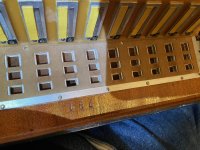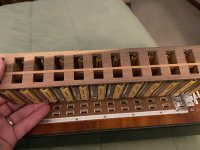The below was written prior to disassembling the thing again and borrowing the neighbor's phone to take picture... Turns out that the extra pallet for the sixth row which is only opened when the (for want of a better term) "seventh row" bass button is pushed in converter mode. The reed activated is in the next to deepest bass reed bank. A whole extra pallet in the bass machine operating independently of the main/normal pallet only for converter "seventh row/ fourth row down" notes. Who'd'a thunk?
Pictures may follow if I can get the neighbor to email them to me and then load them up.
The "basso profundo" reed on the two reed (low and really low) low C in the convertor mode was slightly hesitant on the pull so I figured I'd check the leather and generally spruce things up while I was at it. Sure enough the leather was up a bit- and replacing it cured the problem.
While I had the blocks out though, I noticed a real oddity; there are three reed blocks with five sets of reeds (usual twelve notes per set) but there are six rows of openings in the foundation plate for those blocks. The largest bass reed block has two chambers; one for the big mama bass and one for the bass reeds. That latter set's block opening is large enough to cover both the lower level openings.
There are two functioning slides- one for each of the two rows (this in addition to four other slides for the remaining four rows of openings). The register switches all work smoothly and allow neither, either, or both of the two deep bass slides to open and close. So far so good...
The pallets under the two deep bass rows only open the next to bottom row. Open or closed slide, the bottom set of openings is shut by the suede on the other side of the foundation plate. As the appropriate button is pushed the remaining five openings are opened or closed but there is no movement at the bottom row. The leather is not somehow "detached from the pallet and stuck to the back of the foundation plate"- that I could confirm through judicious poking with a thin wood dowel.
The convertor plays well with all appropriate reeds sounding in both settings (two configurations) and the other bass registers all work well. Enough air comes through from the one opening to sound the deep bass reeds- two might well be too much.
Is this a manufacturer's choice set up with a whole redundant slide and set of openings in the foundation plate to allow hardware from non converter models to be used across the line, or is there some weird set up in the bowels of the bass machine that engages the last row of openings (again, the slide opens and closes just fine)? It'd have to be an additional one row pallet set which seems unlikely in the extreme.
I haven't had the heart to pull the bass machine to examine in detail since all seems to work just fine and appears to be working as it should (the pallets open and close smoothly and soundly for the other five rows of openings), but it seems a bit odd. Any insights from the assembled accordion repair brain trust?
Henry
Pictures may follow if I can get the neighbor to email them to me and then load them up.
The "basso profundo" reed on the two reed (low and really low) low C in the convertor mode was slightly hesitant on the pull so I figured I'd check the leather and generally spruce things up while I was at it. Sure enough the leather was up a bit- and replacing it cured the problem.
While I had the blocks out though, I noticed a real oddity; there are three reed blocks with five sets of reeds (usual twelve notes per set) but there are six rows of openings in the foundation plate for those blocks. The largest bass reed block has two chambers; one for the big mama bass and one for the bass reeds. That latter set's block opening is large enough to cover both the lower level openings.
There are two functioning slides- one for each of the two rows (this in addition to four other slides for the remaining four rows of openings). The register switches all work smoothly and allow neither, either, or both of the two deep bass slides to open and close. So far so good...
The pallets under the two deep bass rows only open the next to bottom row. Open or closed slide, the bottom set of openings is shut by the suede on the other side of the foundation plate. As the appropriate button is pushed the remaining five openings are opened or closed but there is no movement at the bottom row. The leather is not somehow "detached from the pallet and stuck to the back of the foundation plate"- that I could confirm through judicious poking with a thin wood dowel.
The convertor plays well with all appropriate reeds sounding in both settings (two configurations) and the other bass registers all work well. Enough air comes through from the one opening to sound the deep bass reeds- two might well be too much.
Is this a manufacturer's choice set up with a whole redundant slide and set of openings in the foundation plate to allow hardware from non converter models to be used across the line, or is there some weird set up in the bowels of the bass machine that engages the last row of openings (again, the slide opens and closes just fine)? It'd have to be an additional one row pallet set which seems unlikely in the extreme.
I haven't had the heart to pull the bass machine to examine in detail since all seems to work just fine and appears to be working as it should (the pallets open and close smoothly and soundly for the other five rows of openings), but it seems a bit odd. Any insights from the assembled accordion repair brain trust?
Henry
Last edited:


